- AI
- Molecular Imaging
- CT
- X-Ray
- Ultrasound
- MRI
- Facility Management
- Mammography
Multislice CTA depicts celiac artery variants
The celiac artery is the largest artery in the abdomen and supplies a number of major upper abdominal organs, including the liver, spleen, stomach, and pancreas, through its branches. An appreciation of this arterial anatomy is important when planning surgery and image-guided interventions.
The success of procedures such as liver transplantation, intestinal anastomosis, intra-arterial chemotherapy, chemoembolization, and radioembolization, requires a detailed knowledge of the celiac artery and its branches. This should include an awareness of any anatomical variants, which are extremely common in these vessels. For instance, when embolization in the liver is planned, it is essential that interventional radiologists know of any variations in the blood supply feeding the liver tumors and surrounding organs. This knowledge may help achieve complete embolization at the target site and also prevent embolic materials from straying into other vessels.
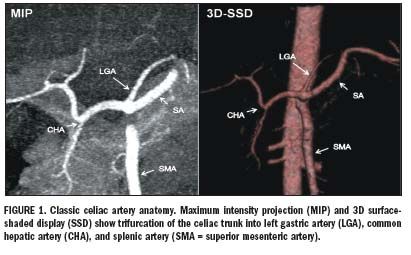
Angiography is the gold standard for demonstrating vascular anatomical variants. But it is invasive and carries the risk of procedural complications. The use of noninvasive techniques, such as CT and MRI, in this role has been limited by the low resolution of images and slow acquisition speeds. The introduction of multislice CT (MSCT) scanners, which enable large volumes of data to be acquired within a few seconds, means that high-resolution 3D imaging can now be performed easily.
Reformatted CT images, obtained with various software tools, can be used to demonstrate the celiac vascular anatomy and its relationship to other structures, the bile duct and portal vein, for example. CT angiography can also display arterial anatomy in different planes and projections, similar to the images obtained with angiography. MSCT has consequently become a valuable noninvasive tool for imaging normal vascular anatomy and its variants and pathological conditions affecting major abdominal vessels.
FROM NORMAL TO ABNORMAL
The celiac artery arises from the ventral surface of the abdominal aorta at the level of the 12th thoracic vertebra and T12-L1 intervertebral disc space. It courses caudally for a short distance, then forms a branching structure. The classic description of normal celiac anatomy is that the main trunk trifurcates into the left gastric artery, the splenic artery, and the common hepatic artery1 (Figure 1). In fact, the length and course of the celiac artery are variable and its branches frequently arise separately from the trunk. Several other branches may additionally arise from the celiac trunk, for example, inferior phrenic arteries, the dorsal pancreatic artery, and the middle colic artery.2 Variations on normal celiac arterial anatomy are also often associated with branching pattern variants of the superior mesenteric artery.
Variations to the aorta’s anterior branches can be explained embryologically. 3 The paired dorsal aorta gives rise to a series of paired vitelline arteries, also called primitive digestive trunks, which are the precursor to the future digestive vessels. As the vitelline arteries fuse, the 10th pair usually forms the celiac artery, the 13th pair forms the superior mesenteric artery, and the 21st or 22nd pair forms the inferior mesenteric artery.
A ventral longitudinal arterial anastomosis exists between the 10th, 11th, 12th, and 13th roots. The 11th and 12th roots normally disappear, leaving the anastomizing vessel with the 10th root. This gives rise to the celiac artery, which divides into the left gastric artery, the splenic artery, and the common hepatic artery.
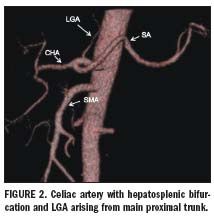
Variations of the celiac artery and superior mesenteric artery are explained by the persistence of some or all of the primitive ventral anastomoses of the vitelline arteries and associated variations in the 10th and 13th vitelline roots.
COMMON, UNCOMMON VARIANTS
Several authors have studied and classified anatomical variants in celiac anatomy. This work includes the identification of eight types of celiac artery based on celiac and mesenteric artery branching, and 10 types based on hepatic artery origins.4,5
The trifurcation of the celiac artery into the hepatic, splenic, and left gastric arteries was accepted as the description of normal anatomy for many years. A gastrosplenic trunk is formed when the hepatic artery is absent, a hepatosplenic trunk is formed when the left gastric artery is missing, and a hepatogastric trunk is formed when there is no splenic artery arising from the celiac artery.
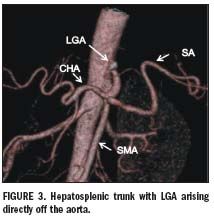
If two main branches are absent, there will be no celiac trunk and all three main branches may then originate independently from the aorta (1% to 2% of cases).4-7 The three main branches of the celiac artery and the superior mesenteric artery can sometimes arise from a common (celiacomesenteric) trunk (2%). Absent branches may also originate from the aorta or one of the remaining two main arteries.6,7
Celiac arterial anatomy most commonly consists of a hepatogastrosplenic trunk with either a branching trifurcation (Figure 1), a hepatosplenic bifurcation (type I, Figure 2), or a gastrosplenic bifurcation (73% to 85%).4 A hepatosplenic trunk (type II, Figure 3) will be seen in 3% to 13% of cases, a hepatogastric trunk (type III) in 2% of cases, and a hepatosplenomesenteric trunk (type IV, Figure 4) in 1% of cases. A variant of type IV would be a hepatomesenteric trunk (Figure 5).
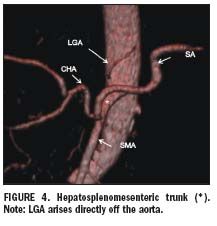
Less common arterial structures include the existence of a gastrosplenic trunk (0.5% to 12%) (type V), a celiacomesenteric trunk (type VI, Figure 6) (0.5% to 2%), and a celiacocolic trunk (type VII) (1.5%), where the middle colic artery arises from the celiac artery. The absence of the celiac trunk, discussed above, is referred to as type VIII. The right hepatic artery will often arise from the superior mesenteric artery. This common variation can occur with any of the above variants.
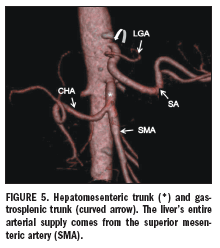
Multislice CTA enables rapid acquisition of thin-slice, high-resolution images of the abdominal arteries during the phase of maximum contrast enhancement. Volumetric data acquisition permits 3D image reconstruction, allowing the relationship of arteries to adjacent organs and the biliary tree to be displayed. The course of the aberrant vessel is also delineated clearly. This may be of great value because direct visualization of the surgical field is often limited in patients with pancreatic and hepatobiliary malignancy.8
Recognition of a variant splanchnic arterial supply has important diagnostic and therapeutic implications. Preoperative knowledge of variant anatomy may reduce the need for extensive dissection to identify vessels, and may avert vascular damage. CTA has a reported accuracy of more than 95% for the detection of arterial variants.9,10
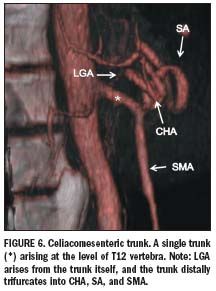
An awareness of celiac artery variants is extremely important. If a patient with a celiacomesenteric trunk undergoes pancreatic surgery, for example, most abdominal organs will be at risk of ischemic injury when the clamp is applied across the trunk because the usual collateral supply from the superior mesenteric artery is not present. Similarly, embolization in a patient with a hepatogastric artery variant could result in reflux of the chemotherapeutic or radioembolization agent into the gastric artery. This may cause severe complications, such as gastric ulcers and perforation. Preemptive embolization of the gastric artery with coils may be carried out if the anatomy is known in advance, thereby minimizing complications.
The identification of variants such as a replaced hepatic artery is critical when performing pancreatico-duodenectomies and for dissection of the porta hepatis. Using palpation to detect the presence of an artery can be unreliable when there is portal inflammation, enlarged portal lymph nodes, or an existing biliary stent.
In conclusion, celiac artery variants can influence surgical procedures and the planning of image-guided interventions. It is consequently important for radiologists to know of the different celiac artery variants that can be demonstrated easily on CTA.
Can a CT-Based Radiomics Model Bolster Detection of Malignant Thyroid Nodules?
May 3rd 2024A computed tomography (CT)-based radiomics model that includes 28 radiomic features showed significantly higher accuracy, sensitivity, and specificity than conventional CT in differentiating benign and malignant thyroid nodules, according to newly published research.
Contrast-Enhanced Mammography and Dense Breasts: What a New Meta-Analysis Reveals
May 1st 2024The 10-study meta-analysis demonstrated that contrast-enhanced mammography has a 95 percent sensitivity rate and an 81 percent specificity rate for diagnosing suspicious lesions in women with dense breasts.
